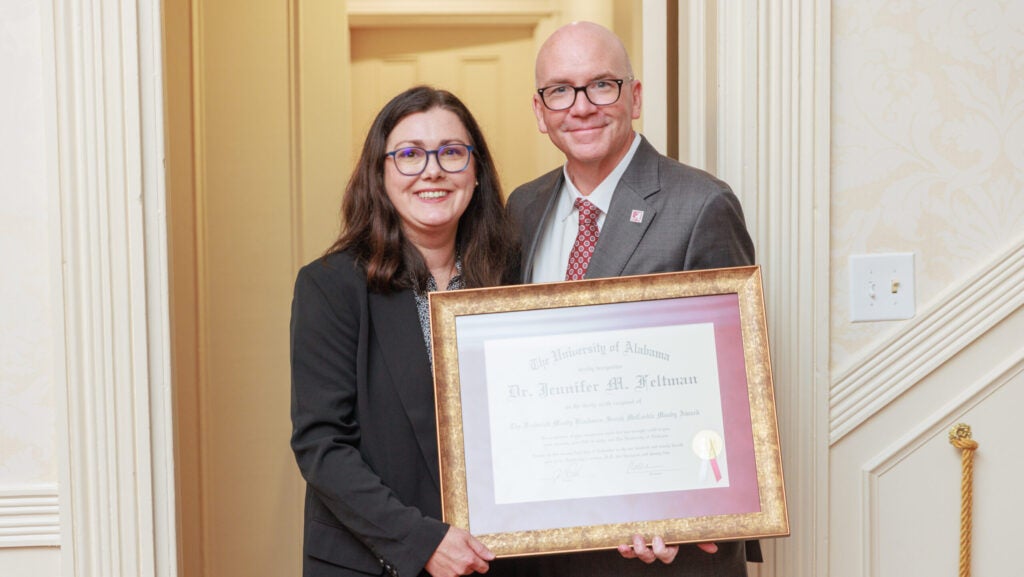Dr. Jennifer Feltman, associate professor of medieval art and architecture, is the 2025 recipient of the Blackmon-Moody Outstanding Professor Award.

An internationally-recognized specialist in French Gothic architecture and sculpture, she conducts research integrating art history, scientific methods, and digital technology to investigate the design, interpretation, and restoration of Gothic cathedrals and their sculptures over time. Notably, Feltman has received acclaim for her role in restoring Notre-Dame de Paris, the world’s most famous cathedral. She was honored at the award reception at the President’s Mansion on Nov. 21.
“For a scholar of Gothic architecture, it has been an opportunity of a lifetime to have been part of an international team that was united by a common vision to see the cathedral renewed,” Feltman said. ”I’ve been fortunate to have been part of something much bigger than myself and to bring that experience back to the University through research and teaching.”
In 2019, Feltman was appointed to the Chantier scientifique de Notre-Dame, the team of scientists and historians authorized by the French Ministry of Culture and French National Research Center to study the cathedral during restoration. Through this appointment, she developed the international collaborative research project “Notre-Dame in Color” with support from a 2022 Albertine Foundation – Transatlantic Research Partnership, a program of the French Embassy in the United States. This grant established the first research partnership between The University of Alabama and Sorbonne Université in Paris.
Feltman continues to direct the on-going project to digitally document, analyze, historically contextualize, and digitally recreate the original vibrant colors of the sculptures of Notre-Dame. This year she has been giving public talks on the project for the Villa Albertine, the arts and culture branch of the French Embassy in New York and Washington, D.C. In recognition of her partnership with France, Dr. Fabrice Rozié, cultural attaché and director of the Villa Albertine at the Consulate General of France in Atlanta spoke briefly at the award reception.
The author or co-editor of two books and a forthcoming monograph, Feltman has also published a combined total of 16 peer-reviewed articles and book chapters on Gothic sculpture and art. At present, she is editing “Notre-Dame in Color: The Art and Science of Polychromy,” which includes ten chapters by art historians, digital artists, scientists and technologists.
After discovering a lost head from a sculpture from Notre-Dame in the Nasher Museum of Duke University, Feltman was appointed in 2023 to the French national archaeological team (Inrap) tasked with digitally reconstructing the newly discovered 1,000 sculpture fragments of the 13th-century choir screen that once depicted the Passion of Christ. This research was featured in the PBS-NOVA documentary, “Lost Tombs of Notre-Dame.” The discovery also led to her appointment as co-director of the Limestone Sculpture Provenance Project, which is affiliated with the International Center of Medieval Art at the Met Cloisters Museum in New York.
Collaborations with computer scientists and digital artists have allowed Feltman to advance research and public interest in Gothic architecture. The VR Cathedral for Meta Quest, funded by UA’s first Whiting Foundation grant, was piloted in 2021 in Tuscaloosa City Schools. Feltman was recently a co-mentor of the Google Summer of Code 2025 project, “Healing Stones,” for Human-AI.org. The team used machine learning to reconstruct fragmented sculptures using 3D digital models.
The Blackmon-Moody Outstanding Professor Award recognizes distinctive, extraordinary or timely achievement in the areas of research that has the ability to “captivate the imagination,” and Feltman resonates with that value.
“This is exactly the aspect of art history that got me into the field in the first place, and it is what led me to be involved in the Notre-Dame restoration project,” she said. “As it turns out, inspiring the imagination can have long-lasting and significant impact on people’s lives and the world around us for the better. I’m thankful to the Blackmon-Moody family for establishing this award.”
Since her office is in Garland Hall, home of the Sarah Moody Gallery of Art, Feltman feels a special sense of connection to the award that was established in Sarah McCorkle Moody’s memory. “It was Sarah Moody who donated the first piece of art to the department in 1950: a Picasso!” Feltman said. “In some way, her love of art and her generosity has come full circle back to the department of art and art history where I have the privilege of teaching UA students.”
“The Blackmon-Moody award confirms to me that the things I care about are things that others care about,” Feltman said. “This gives me hope for the future of the arts and the humanities.”